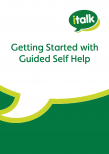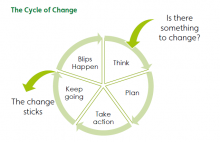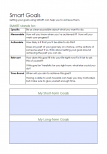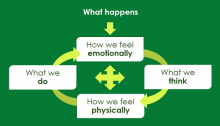Patient Area
Getting Started with Guided Self-Help
Here you'll find all the worksheets and information you'll need to accompany your learning for your Getting Started with Guided Self-Help webinar.
What we learned
In this session we explored what Guided Self-Help is, how it helps, and what you can expect from your treatment.
Guided Self-Help is a treatment using Cognitive Behavioural Therapy (CBT) to help ease symptoms of depression and anxiety. Through these sessions, you’ll set goals for your wellbeing, and learn skills and techniques that you can use towards achieving them.
What guided self-help helps with
Guided Self-Help is a treatment for depression and anxiety, including anxiety disorders like OCD and specific phobias.
Everyone’s experience with depression and anxiety can be different, but some common symptoms are:
| Depression: | Anxiety: |
|---|---|
|
|
We learned that it’s common to experience some symptoms from each list, as depression and anxiety can be two sides of the same coin. Our symptoms of depression can make us feel anxious or worried, and symptoms of anxiety can make us feel low and hopeless.
In your Guided Self-Help treatment, we’ll focus on the particular symptoms you’re experiencing, and help you to find ways to manage them.
Introduction to Cognitive Behavioural Therapy
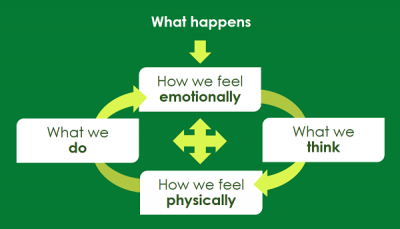
Cognitive Behavioural Therapy is the leading treatment prescribed by the NHS for anxiety and depression and scientifically proven to be effective.
It looks at the links between our emotions, thoughts, actions and physical feelings, because although we often talk about depression and anxiety as affecting how we’re feeling, they actually affect what we do, how we think, and how we feel physically too.
To understand these links, we shared a model call the “5 areas”, which looks at a situation we find difficult, and the way it affects these four areas.
Although we often can’t change the situation, this model helps us to look at what we can change. We can start to use those links to our advantage, making small changes in our actions, that will improve how we think and feel.
We explored an example to see how these links can start to form a ‘vicious cycle’, keeping us from feeling better long after the original situation has passed. Through Guided Self-Help we aim to empower you to break these cycles, and move forward more positively.
Resources:
- Use the 5 Areas worksheet to try exploring your own vicious cycles
How Guided Self-Help Helps
We looked at how your Guided Self-Help sessions will support you to identify the vicious cycles in your life, and find small changes you can make to break them and feel better.
The way Guided Self-Help works, is that you’ll work together as a team with your NHS Talking Therapies Hampshire practitioner.
They’ll help you to set some goals that you want to work towards in your recovery, and they’ll suggest tools and techniques you could use to achieve them. Then, the key to success is that you go ahead and use those tools in your own time.
People often say after treatment that it’s a little bit like learning an instrument, or a sport. You start out with lessons to learn the skills – and that’s your sessions with us. But that’s just the start of the journey, because once you know how to do it, the real improvement comes from practice.
Making Changes
As your Guided-Self Help treatment will involve making small changes in your life, we explored the cycle of change.
We reflected on how we’ve all been through many steps of this cycle in order to attend this session. Before your treatment sessions, it might be helpful to think about where you are in the cycle of change in relation to your Guided Self Help treatment. Are you ready to make changes?
Resources:
Setting Goals
We looked at how your practitioner will work with you to set some wellbeing goals for you to work towards during treatment.
If you want to get started on thinking about the goals you want to set, you can use our Setting Goals worksheet below.
Resource:
How your practitioner can help
We looked at the ‘guided’ part of your Guided Self-Help treatment, and how your practitioner will be your expert guide, supporting you to achieve your goals.
They won’t do things for you, but they will take an active part in your treatment, so that you’ll work together as a team.
That means your sessions will be quite structured. Early sessions will focus on understanding your main problem and setting goals, then your practitioner will teach you tools you can use towards achieving them. In later sessions you’ll review your progress together, celebrate your achievements, and look for ways to move forward.
Next Steps
We hope you found this webinar a helpful way to understand what Guided Self-Help is all about, and how you can get started on preparing for your treatment sessions.
We recommend before your sessions start, trying these activities:
- Take a look at the 5 Areas worksheet, and try filling in your own
- Think about what your main problem is, and try setting some SMART goals that could help towards tackling it.
- Take a look at the Cycle of Change, and celebrate how far you’ve come already.
What if Guided Self Help isn’t for me?
Now that you know a little more about the treatment, if you feel that Guided Self-Help isn’t quite right for you, you can switch to either SilverCloud or Managing Moods.
If you’d like to switch, contact us on 023 8038 3920 or info@italk.org.uk
Getting Started with GSH Booklet (Doc)
Your booklet to accompany the Getting Started with Guided Self-Help webinar…
Click here to download
 Menu
Menu
